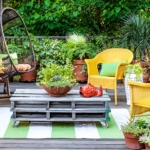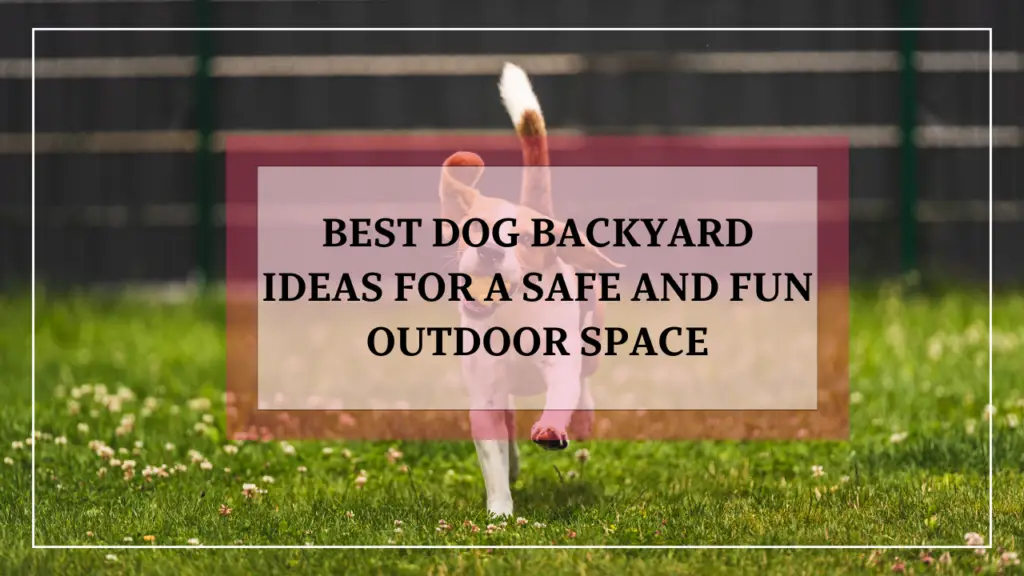
Best Dog Backyard Ideas for a Safe and Fun Outdoor Space
Posted in :
Creating a dog-friendly backyard isn’t just a luxury—it’s a necessity for many dog owners who want to ensure their pets lead happy, healthy lives. Best dog backyard ideas involve designing a space that caters to your dog’s physical and mental needs while also being practical and enjoyable for both you and your furry friend. Whether you have a sprawling lawn or a small patio, there are numerous ways to transform your outdoor space into a dog’s paradise.
Planning Your Dog-Friendly Backyard: Key Considerations
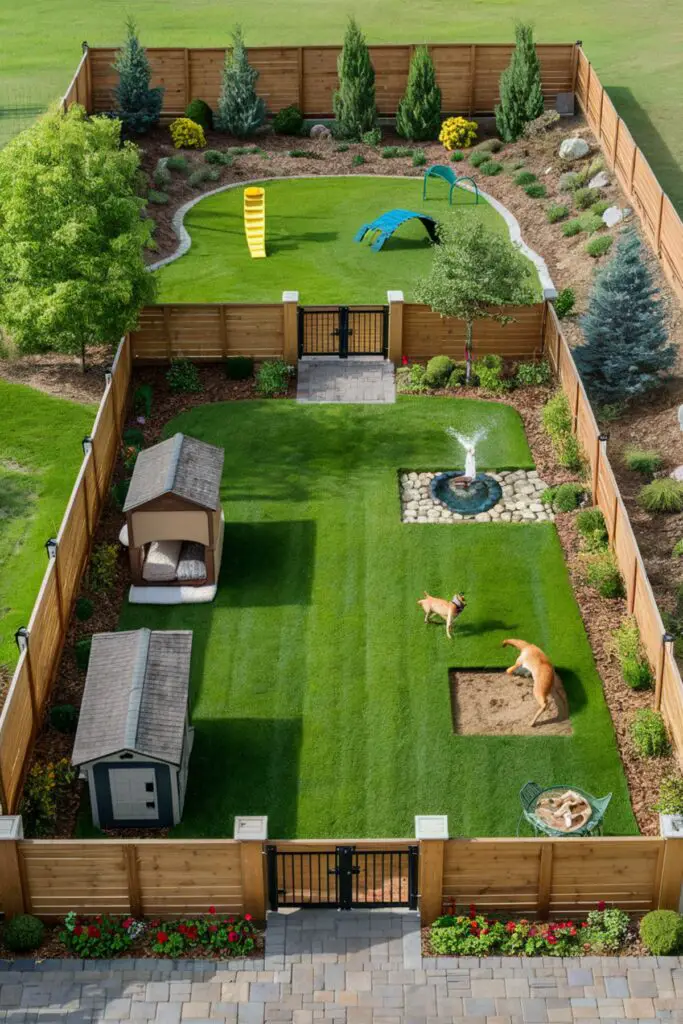
Designing a dog-friendly backyard requires careful planning to ensure it meets your dog’s specific needs while remaining functional and aesthetically pleasing for you. There are several factors to consider, from safety measures to space optimization.
Safety First: Fencing and Boundaries
One of the most important considerations when designing a dog-friendly backyard is safety. Securing the perimeter of your outdoor space with appropriate fencing is crucial for keeping your dog safe and contained. Here are a few fencing options to consider:
- Wooden Fences: A sturdy wooden fence is a classic option that provides privacy and security. Ensure the fence is at least 6 feet tall for larger breeds and 4-5 feet for smaller dogs. Be mindful of gaps between the panels that a smaller dog could slip through.
- Vinyl Fences: Vinyl fences are a low-maintenance, weather-resistant option that can last for years. They are also great for providing privacy and blocking outside distractions that may cause your dog to bark excessively.
- Invisible Fences: These use a combination of buried wires and a special dog collar to keep your dog within a designated area. If you’re considering this option, a highly-rated wireless dog fence system can help establish boundaries without disrupting your yard’s aesthetics.
- Chain-Link Fences: While not as aesthetically pleasing, chain-link fences are durable and effective, particularly for larger dogs. You can enhance the appearance by growing climbing plants or installing privacy slats for better coverage.
Key Fencing Considerations
- Fence Height: For small dogs, a fence height of 4-5 feet is typically sufficient, but larger, more active breeds may require fences at least 6 feet tall to prevent jumping.
- Digging Prevention: Some dogs are notorious diggers. Installing a barrier at the base of the fence, such as buried wire mesh or landscape edging, can prevent your dog from tunneling under.
- Double Gates: For added security, installing a double-gate system can help prevent accidental escapes when entering or exiting the yard.
Size Matters: Small Yards vs. Large Yards
The size of your backyard will significantly influence how you design it for your dog. Whether you have a large, sprawling lawn or a more compact space, there are creative ways to optimize your area.
Backyard Ideas for Small Spaces
When space is limited, vertical design elements and smart use of the available area can turn even the smallest yard into a dog-friendly haven.
- Vertical Play Structures: You can create vertical spaces for your dog by incorporating ramps, stairs, and platforms. A multi-level dog play platform can be a great way to add enrichment without needing much horizontal space.
- Interactive Wall Features: Install interactive elements like treat-dispensing wall-mounted toys or scent trails to engage your dog’s mind and keep them entertained.
Maximizing Space in Large Backyards
If you have a large backyard, you have the luxury of creating various zones that serve different purposes for your dog.
- Running Areas: Designate a section of the yard where your dog can run and chase toys freely. A durable outdoor dog tunnel or fetch machine can add an extra level of fun.
- Activity Zones: Incorporate multiple areas like digging pits, agility courses, and shaded rest spots. Having distinct areas adds variety to your dog’s outdoor experience, keeping them mentally stimulated and physically active.
Whether your space is big or small, the goal is to design a dog-friendly backyard that provides your pet with opportunities to play, explore, and relax safely.
Best Dog Backyard Features for Maximum Fun
Incorporating specific features into your backyard can enhance your dog’s outdoor experience, ensuring they get the physical and mental stimulation they need. From digging zones to agility courses, there are numerous ways to make your backyard engaging and fun for your dog.
Digging Zones and Sand Pits
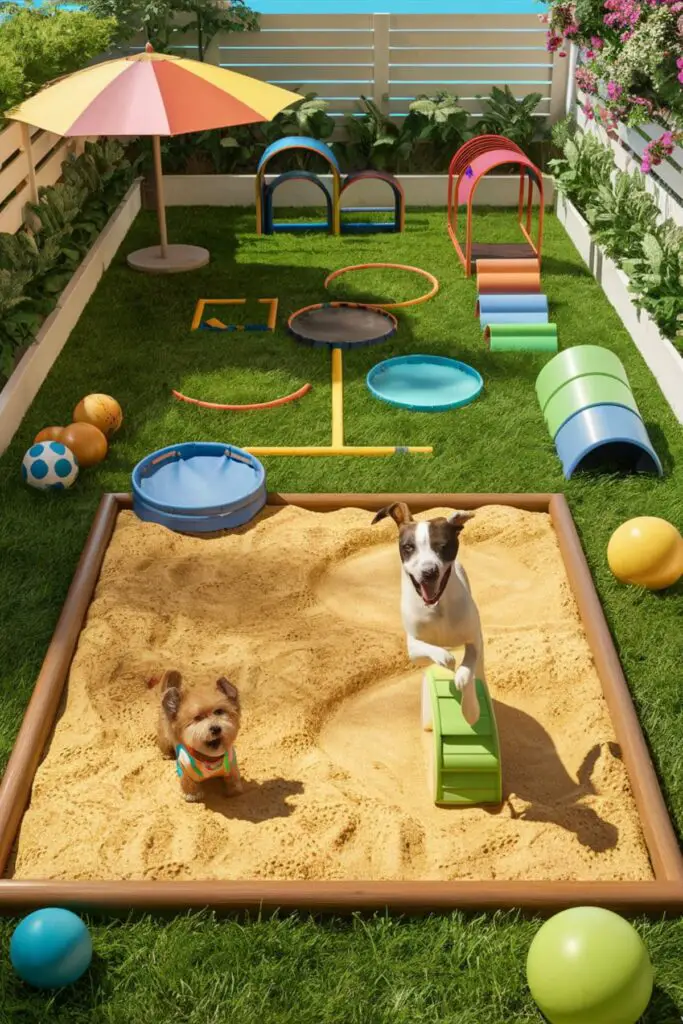
Many dogs love to dig, which can become problematic if they’re tearing up your flower beds or lawn. However, by creating a designated digging area, you can give your dog an outlet for this natural behavior while preserving the rest of your yard.
How to Build a Digging Pit
A simple way to create a dog digging zone is by digging out a shallow area and filling it with sand or soft soil. Sand is a great material because it’s easy for dogs to dig in and less likely to cause damage to their paws. You can also bury durable rubber chew toys or treat-dispensing balls in the pit to encourage your dog to use it.
- Dimensions: For small dogs, a digging pit of about 3 feet by 3 feet will suffice. For larger breeds, consider expanding the size to 6 feet by 6 feet.
- Materials: Opt for non-toxic, chemical-free play sand to ensure your dog’s safety.
- Maintenance: Regularly sift the sand to remove any debris and keep it fresh. A sand sifter rake can make this task easier.
DIY Dog Digging Pit Ideas
- Sandboxes: Repurpose a children’s sandbox for your dog’s digging needs. These are often shallow and easy to cover when not in use.
- Custom Wood-Framed Pits: Create a more permanent structure by building a wooden frame and filling it with sand or dirt. This method adds a more polished look to your yard while keeping the digging contained. A weather-resistant wooden garden bed can serve as a ready-made pit frame.
Agility Course and Obstacle Challenges
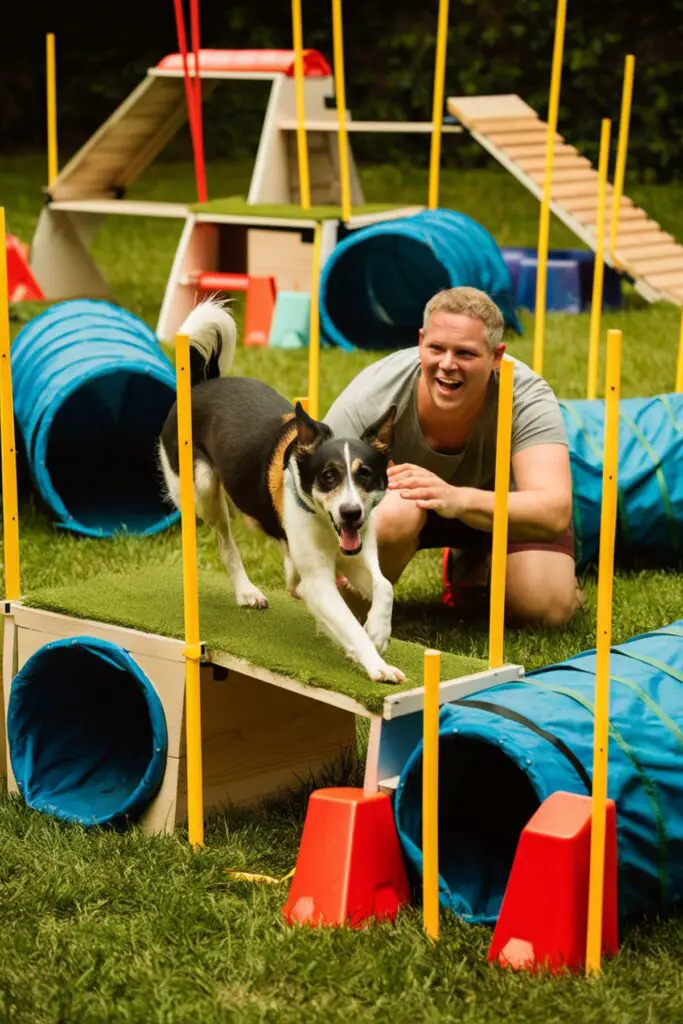
Creating a backyard agility course is not only fun for your dog but also provides them with a mental and physical workout. Agility training improves coordination, enhances obedience, and offers a great bonding opportunity between you and your dog.
Agility Training Benefits
Agility training is beneficial for all breeds, not just working dogs. It challenges a dog’s intelligence, improves focus, and helps release pent-up energy. An agility course can include simple items like tunnels and weave poles or more complex setups like seesaws and hurdles. If you’re just starting, a beginner agility training kit can be a great way to introduce your dog to the basics.
DIY Agility Course Ideas
You can create a simple agility course using items you may already have at home:
- Tunnels: A collapsible tunnel made of durable fabric is perfect for dogs to run through. You can find these at pet stores or get a pop-up dog agility tunnel for easy setup and storage.
- Weave Poles: Use stakes or PVC pipes to create a weave pole course, encouraging your dog to zigzag through them. For a hassle-free setup, a portable weave pole set is a great option.
- Ramps and Platforms: Build ramps or platforms for your dog to climb, which also helps develop balance and coordination. If DIY isn’t your thing, a pre-made dog training ramp can make setup quick and easy.
Dog-Friendly Landscaping Ideas
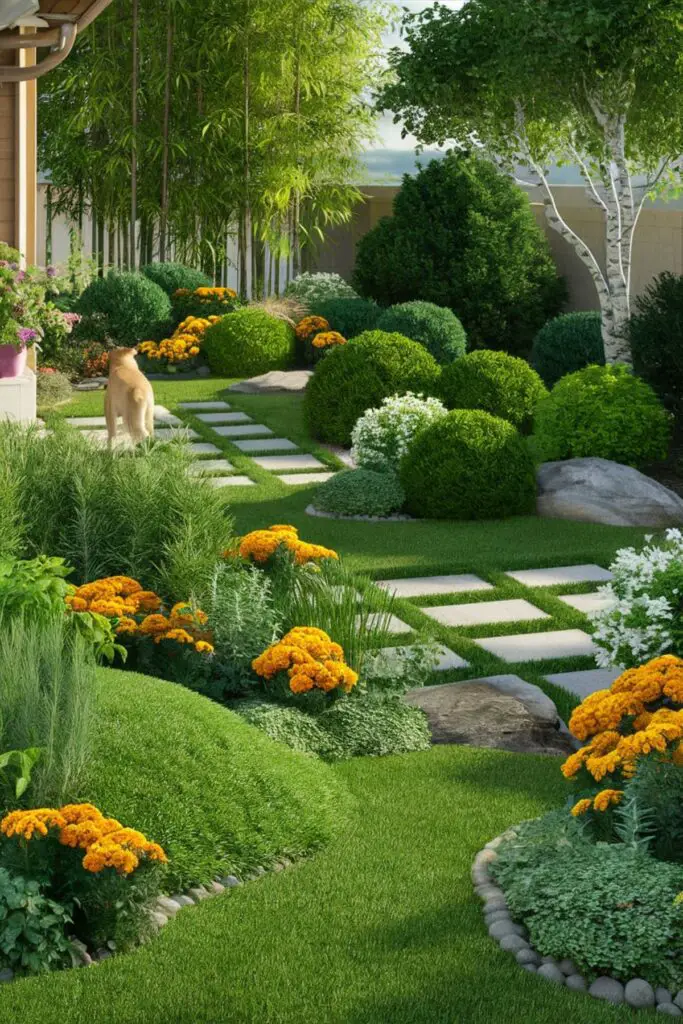
When designing your dog-friendly backyard, the type of landscaping you choose plays a significant role in maintaining safety and comfort. Certain plants and ground covers are better suited for dogs, and thoughtful landscaping can help reduce maintenance while ensuring your dog enjoys the space.
Non-Toxic Plants for Dogs
Not all plants are safe for dogs, so it’s important to choose pet-friendly options. Some popular dog-safe plants include:
- Bamboo: Hardy and easy to maintain, bamboo provides shade and privacy while being safe for dogs.
- Marigolds: These colorful flowers are non-toxic and add a vibrant touch to your backyard.
- Herbs: Rosemary, basil, and thyme are excellent dog-safe herbs that also serve practical culinary uses.
Plants to Avoid:
- Azaleas: These are toxic to dogs and can cause vomiting, diarrhea, and even death if ingested.
- Lily of the Valley: Though beautiful, this plant can cause serious health problems for dogs, including heart issues.
Best Ground Covers for a Dog Backyard
Choosing the right ground cover helps prevent muddy paws and makes the backyard easier to clean and maintain:
- Clover: This low-maintenance plant is soft on paws and highly resistant to dog urine, making it a great option for dog owners.
- Fescue Grass: This grass variety is tough and resilient, able to withstand the wear and tear from running and digging.
- Artificial Turf: For a no-mess, low-maintenance solution, consider installing artificial turf. It’s durable, drains well, and is easy to clean.
Creating Shaded Areas with Trees and Bushes
Dogs love spending time outside, but they also need a cool, shaded area to rest in during hot weather. Planting shade trees or installing bushy shrubs provides natural, comfortable shelter for your dog.
- Trees: Fast-growing trees like maple or birch can provide ample shade without requiring years of growth.
- Bushes: Plant dense bushes like boxwood or juniper to create shady spots and natural barriers in your yard.
Water Features and Splash Zones for Dogs
Adding water features to your dog-friendly backyard can be a great way to keep your dog cool and entertained, especially during warmer months. Dogs, like humans, enjoy playing in water, and having a dedicated splash zone can also help prevent overheating. Here are some ideas for incorporating water into your backyard design.
Dog-Friendly Pools
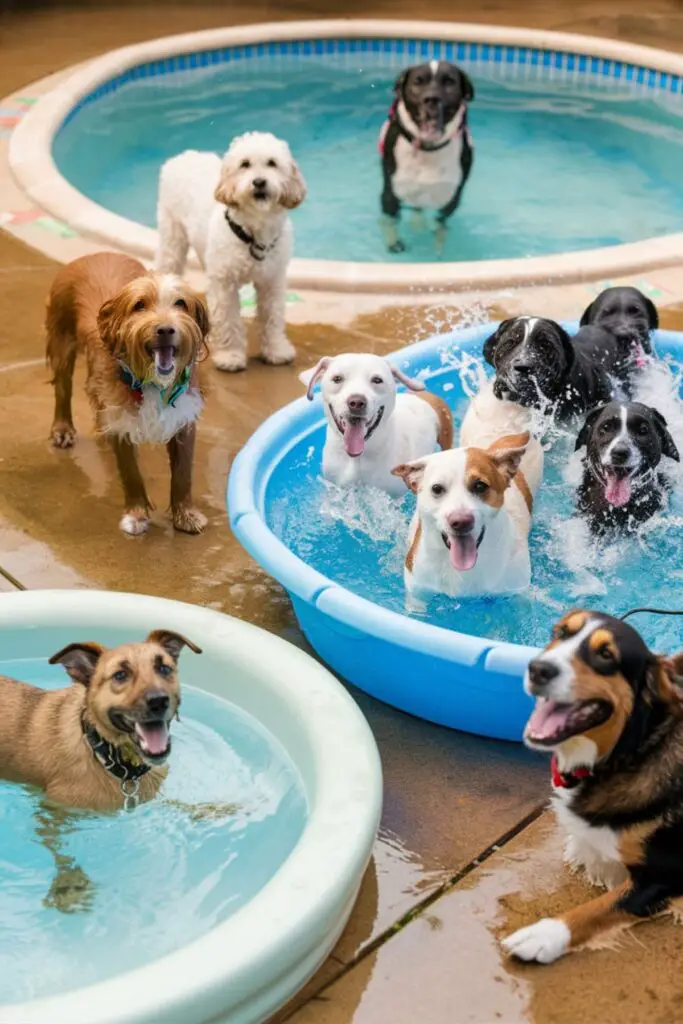
A small, shallow pool can provide hours of entertainment for dogs that love to splash around. These pools don’t need to be large or deep—just enough for your dog to cool off and play safely.
- Kiddie Pools
A kiddie pool is a cost-effective option that works well for small to medium-sized dogs. Made from durable plastic, these pools are easy to fill and empty, and they can be stored away during colder months. Ensure the pool is shallow enough for your dog to enter and exit comfortably, with water levels no higher than chest-deep for small dogs. - In-Ground or Above-Ground Dog Pools
If you’re looking for a more permanent solution, consider installing a dedicated dog pool. In-ground pools can be designed specifically for dogs, with shallow edges for easy access and slip-resistant surfaces to prevent injuries. Above-ground dog pools, while more expensive than kiddie pools, offer greater durability and longevity. - Safety Considerations
- Supervision: Always supervise your dog while they’re in the pool, especially if they’re not strong swimmers.
- Non-Slip Surfaces: To prevent slipping, choose a pool with a textured bottom or add rubber mats to provide grip.
- Fresh Water: Regularly empty and refill pools with fresh water to avoid bacteria buildup and keep your dog healthy.
Splash Pads and Sprinklers
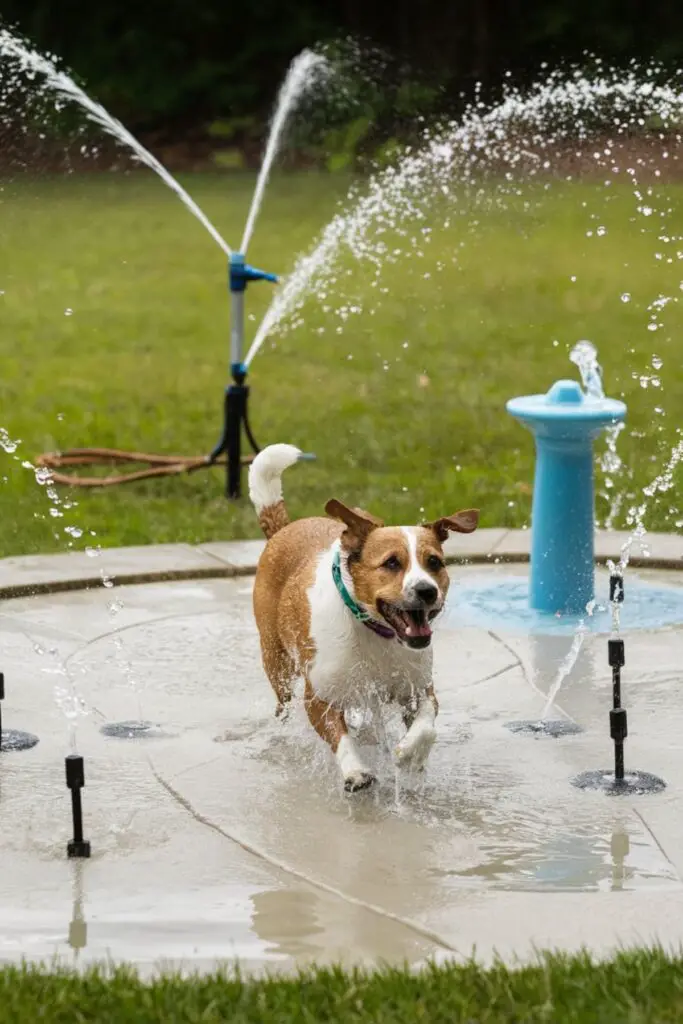
If your dog loves running through sprinklers or splashing around in water, a splash pad might be the perfect addition to your backyard.
Best Backyard Ideas for Specific Dog Breeds
Each dog breed has unique needs based on their size, energy levels, and temperament. By tailoring your backyard to suit your dog’s specific breed, you can create a space that not only meets their physical needs but also stimulates them mentally.
Backyard Ideas for Small Dogs
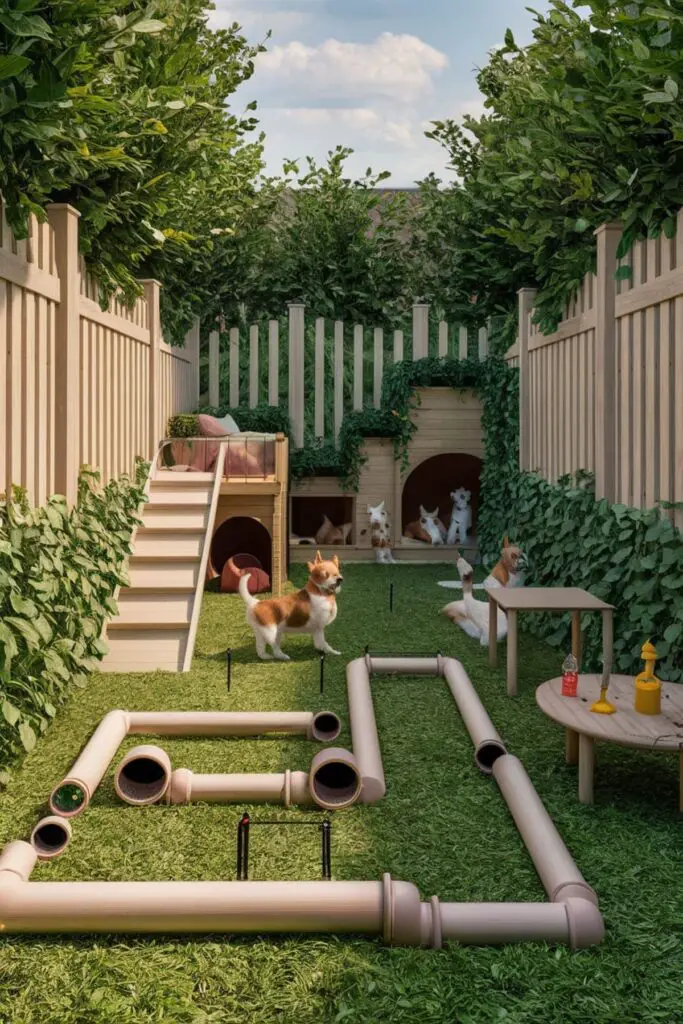
Smaller dog breeds, such as Chihuahuas, Pomeranians, and Dachshunds, have distinct needs compared to their larger counterparts. A well-designed backyard for small dogs should focus on safety, comfort, and scaled-down features that match their size and activity levels.
Best Backyard Setup for Small Dogs
When setting up a backyard for small dogs, it’s essential to consider safety first. Smaller breeds are more vulnerable to predators like birds of prey, so having some form of overhead protection or shaded areas is beneficial.
- Fencing: Ensure the fence is tall enough to keep them secure but with smaller gaps to prevent them from squeezing through. Mesh or picket fences work well for small breeds.
- Soft Ground Cover: Small dogs often have delicate paws. Ground covers like clover or artificial turf are great options as they provide a soft surface and are easy to maintain.
- Interactive Play Areas: Create small spaces with interactive toys like puzzle feeders, or use small agility obstacles to keep your dog mentally engaged without overwhelming them.
Backyard Ideas for Large Dogs
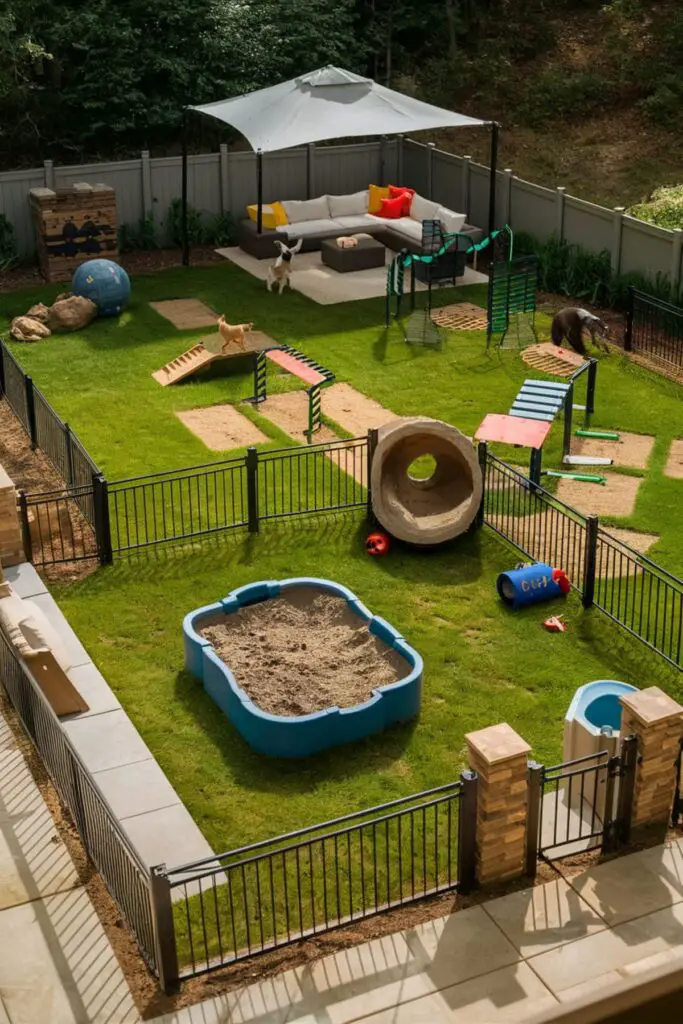
Large dog breeds, such as German Shepherds, Labradors, and Great Danes, require more space and durable equipment to match their higher energy levels and physical strength. When designing a backyard for larger breeds, focus on creating areas where they can run, explore, and play without constraints.
Designing for Larger Breeds
For larger dogs, it’s important to design a backyard that allows for ample movement, physical activities, and durability. Here’s how to create the best backyard setup for large dogs:
- Large Digging Pits: Larger breeds, especially digging-prone dogs like terriers, can benefit from a sizable digging pit. A pit that’s around 5-6 feet wide and deep enough to give them room to dig without damaging the rest of your yard will help satisfy their instincts.
- Spacious Running Areas: Larger dogs need space to stretch their legs. Consider leaving open areas in your backyard where they can run freely. Open grassy areas or artificial turf fields can serve as a low-maintenance running zone.
- Agility Equipment: Larger dogs often enjoy physical challenges. Incorporate large agility equipment, such as higher jumps, long tunnels, and wide ramps. These features help develop your dog’s agility and provide a productive outlet for their energy.
Heavy-Duty Fences and Durable Outdoor Equipment
Larger breeds require sturdy and durable outdoor structures that can withstand their strength and activity levels:
- Heavy-Duty Fencing: For larger dogs, it’s essential to have strong, heavy-duty fences that are at least 6 feet high to prevent escapes. Chain-link fences, reinforced wood, or vinyl options work well. Be sure to check for any weak points or areas where your dog might be able to dig under the fence.
- Durable Toys and Equipment: Large dogs can be rough on toys and equipment. Opt for heavy-duty outdoor toys made from rubber or thick plastic to ensure they last. Agility equipment should also be sturdy and anchored securely to the ground to prevent it from toppling over.
- Shaded Rest Areas: Larger breeds can easily overheat, especially during high-energy play sessions. Be sure to incorporate shaded areas with large trees or a covered pergola where they can cool off.
Budget-Friendly Dog Backyard Ideas
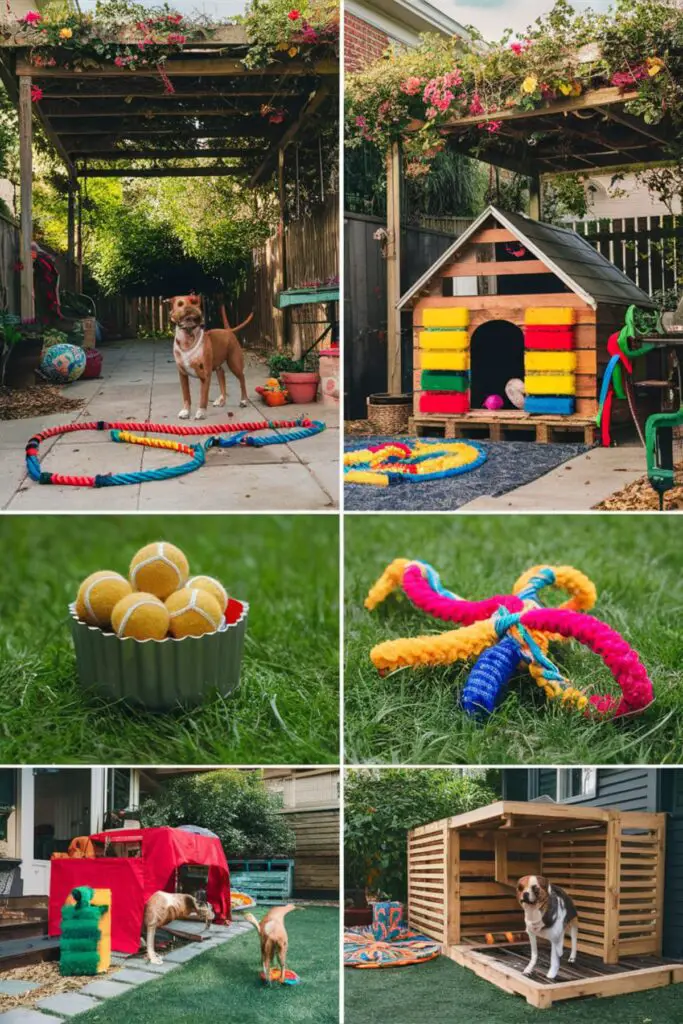
Creating a dog-friendly backyard doesn’t have to break the bank. With a bit of creativity and some DIY skills, you can build a space that’s both fun and functional for your furry friend. Here are some budget-friendly ideas to transform your backyard into a paradise for your dog without spending a fortune.
Building Your Own Dog House or Shaded Play Area
Constructing your own dog house or shaded play area can be a rewarding project that provides your dog with comfort and protection. Here’s how to get started:
- DIY Dog House: Use wooden pallets or repurposed wood to build a simple dog house. Ensure the house is well-ventilated and insulated to keep your dog comfortable in all weather conditions. A basic design includes a raised platform to keep your dog dry and a slanted roof to shed rain.
- Materials Needed: Wood pallets, screws, a saw, and a hammer. Optional: Insulation materials for added comfort.
- Building Tips: Ensure the dog house is large enough for your dog to stand, turn around, and lie down comfortably. Paint or seal the wood to protect it from the elements.
- Shaded Play Area: Construct a shaded play area using inexpensive materials like PVC pipes and fabric. Create a frame and drape it with outdoor fabric or tarps to provide shade.
- Materials Needed: PVC pipes, fabric or tarp, and connectors.
Building Tips: Secure the frame to prevent it from tipping over. Ensure the fabric or tarp is tightly stretched to provide effective shade.
How to Create a Dog-Friendly Backyard on a Budget
Transforming your backyard into a dog-friendly space doesn’t have to be expensive. Here are some budget-friendly tips to make it happen:
- Repurpose and Reuse: Look for items around your home that can be repurposed for your dog’s backyard. Old furniture, garden tools, or unused containers can be turned into dog-friendly features.
- Affordable Ground Cover: Use inexpensive ground covers like clover or grass seeds to create a comfortable surface for your dog to play on. Clover is particularly good for reducing muddy areas and is low-maintenance.
- DIY Obstacles: Create agility obstacles using materials you have at home. For example, use broomsticks and PVC pipes for jumps, or old tires for tunnel exercises. These can be assembled with minimal cost and provide your dog with fun, challenging activities.
- Garden Edging: Use inexpensive garden edging materials to create defined play areas or digging zones. This not only helps to organize the space but also keeps the area tidy and functional.
- Natural Shade Solutions: Plant fast-growing, shade-providing plants like bamboo or use old sheets and tarps to create shade areas without spending much.
